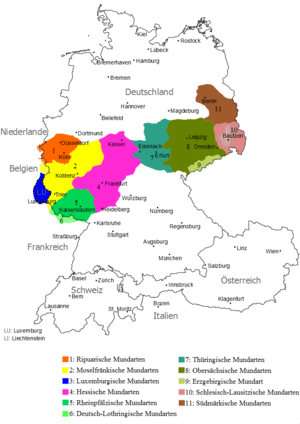East Central German
| East Central German | |
|---|---|
| Native to | Germany |
| Region | Thuringia, Saxony, Berlin, Brandenburg |
|
Indo-European
| |
| Language codes | |
| ISO 639-3 | – |
| Glottolog | None |
|
Central German dialects
Thuringian (7)
Upper Saxon (8)
Erzgebirgisch (9)
Lusatian (10)
Berlin Brandenburgish (11) | |
East Central German is the eastern, non-Franconian sub-group of Central German dialects, themselves part of High German. Present-day Standard German as a High German variant[1] has actually developed from a compromise of East Central (especially Upper Saxon promoted by Johann Christoph Gottsched) and East Franconian German. East Central German dialects are mainly spoken in Central Germany and parts of Brandenburg, and were formerly also spoken in Silesia and Bohemia.
Dialects
East Central German is spoken in large parts of what is today known as the cultural area of Central Germany (Mitteldeutschland). It comprises:
- Thuringian (Thüringisch)
- Upper Saxon German (Obersächsisch)
- Erzgebirgisch
- Lower and Upper Lusatian (Lausitzisch)
- Berlin-Brandenburgish (Südmärkisch), as distinct from Low German Brandenburgish (Markish)
and further:
- Silesian German (Schlesisch) (nearly extinct)
- High Prussian (Hochpreußisch) (nearly extinct)
See also
Further reading
- Keller, R. E. (1960) German Dialects: phonology and morphology. Manchester U. P.
References
- ↑ "Ethnologue: East Middle German". Retrieved 2010-11-24.
This article is issued from Wikipedia - version of the Friday, January 16, 2015. The text is available under the Creative Commons Attribution/Share Alike but additional terms may apply for the media files.
